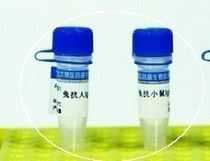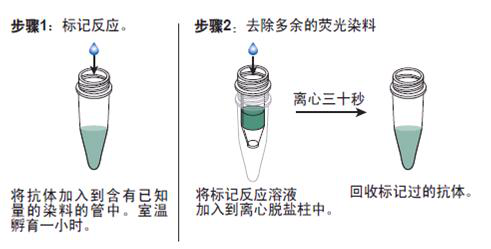
|

| 产地 | 进口、国产 |
| 品牌 | 上海莼试 |
| 保存条件 | Store at -20 °C |
| 货号 | CS10649 |
| 应用范围 | WB=1:100-500 ELISA=1:500-1000 IP=1:20-100 IHC-P=1:100-500 IHC-F=1:100-500 ICC=1:100-500 IF=1:100-500 |
| CAS编号 | |
| 抗体名 | Anti-PDGFRA |
| 克隆性 | |
| 靶点 | 详见说明书 |
| 适应物种 | 详见说明书 |
| 形态 | 详见说明书 |
| 宿主 | 详见说明书 |
| 亚型 | IgG |
| 标识物 | 详见说明书 |
| 浓度 | 1mg/1ml% |
| 免疫原 | KLH conjugated synthetic peptide derived from human PDGF-R-A (1041-1089aa) |
抗体的生物素化标记实验要点:
1. 血小板源性生长因子受体A抗体(PDGFRα)费用 如在反应混合液中有叠氮钠或游离氨基存在,会抑制标记反应。因此,蛋白质在反应前要对 0.1mol/L碳酸氢钠缓冲液或0.5mol/L硼酸缓冲液充分透析;
2.所用的NHSB及待生物素化蛋白质之间的分子比按蛋白质表面的ε-氨基的密度会有所不同,选择不当则影响标记的效率,应先用几个不同的分子比来筛选最适条件;
3.用NHSB量过量也是不利的,抗原的结合位点可能因此被封闭,导致抗体失活;
4.由于抗体的氨基不易接近可能造成生物素化不足,此时可加入去污剂如 Triton x-100, Tween20等;
5.当游离ε-氨基(赖氨酸残基的氨基)存在于抗体的抗原结合位点时,或位于酶的催化位点时,生物素化会降低或损伤抗体蛋白的结合力或活性;
6.生物素还可能与不同的功能基团,如羰基、氨基、巯基、异咪唑基及*基,也可与糖基共价结合;
7.交联反应后,应充分透析,否则,残余的生物素会对生物素化抗体与亲和素的结合产生竞争作用;
8.在细胞的荧光标记实验中,中和亲和素的本底低,但由于链霉亲和素含有少量正电荷,故对某些细胞可导致高本底。
产品订购信息:
英文名称 Anti-PDGFRA
中文名称 血小板源性生长因子受体A抗体(PDGFRα)费用
别 名 PDGF Receptor alpha; Platelet–dirived growth factor receptor-alpha; Alpha platelet derived growth factor receptor; CD 140a; CD140a; CD140a antigen; MGC74795; PDGF alpha chain; PDGF R alpha; PDGFR 2; PDGFR A; PDGFR alpha; PDGFR2; PDGFRA; Platelet derived growth factor receptor 2; Platelet derived growth factor receptor alpha; Platelet derived growth factor receptor alpha polypeptide; PGFRA_HUMAN.


浓 度 1mg/1ml
规 格 0.1ml/100μg 0.2ml/200μg
抗体来源 Rabbit
克隆类型 polyclonal
交叉反应 Human, Mouse, Rat, Chicken, Dog, Pig, Cow, Horse
产品类型 一抗
研究领域 心 信号转导
蛋白分子量 predicted molecular weight: 117kDa
性 状 Lyophilized or Liquid
免 疫 原 KLH conjugated synthetic peptide derived from human PDGF-R-A (1041-1089aa)
亚 型 IgG
纯化方法 affinity purified by Protein A
储 存 液 0.01M PBS, pH 7.4 with 10 mg/ml BSA and 0.1% Sodium azide
血小板源性生长因子受体A抗体(PDGFRα)费用 产品应用 WB=1:100-500 ELISA=1:500-1000 IP=1:20-100 IHC-P=1:100-500 IHC-F=1:100-500 ICC=1:100-500 IF=1:100-500
(石蜡切片需做抗原修复)
not yet tested in other applications.
optimal dilutions/concentrations should be determined by the end user.
保存条件 Store at -20 °C for one year. Avoid repeated freeze/thaw cycles. The lyophilized antibody is stable at room temperature for at least one month and for greater than a year when kept at -20°C. When reconstituted in sterile pH 7.4 0.01M PBS or diluent of antibody the antibody is stable for at least two weeks at 2-4 °C.
Important Note This product as supplied is intended for research use only, not for use in human, therapeutic or diagnostic applications.
产品介绍 The PDGF Receptor Type A (Alpha platelet-derived growth factor receptor precursor, CD140a antigen), a 170kD protein, binds all three isoforms of PDGF with high affinity whereas the PDGF Receptor Type B, a 190kD protein, appears to bind only the PDGF BB homodimer with high affinity. Both receptors are transmembranous, ligand activated protein tyrosine kinases, which phosphorylate a number of important signal transduction proteins, which are bound with differential affinities via SH2 domains. The response of any given cell to PDGF will depend on the types of receptors displayed on the surface and isoforms of PDGF present in the extracellular environment.
Function : Tyrosine-protein kinase that acts as a cell-surface receptor for PDGFA, PDGFB and PDGFC and plays an essential role in the regulation of embryonic development, cell proliferation, survival and chemotaxis. Depending on the context, promotes or inhibits cell proliferation and cell migration. Plays an important role in the differentiation of bone marrow-derived mesenchymal stem cells. Required for normal skeleton development and cephalic closure during embryonic development. Required for normal development of the mucosa lining the gastrointestinal tract, and for recruitment of mesenchymal cells and normal development of intestinal villi. Plays a role in cell migration and chemotaxis in wound healing. Plays a role in platelet activation, secretion of agonists from platelet granules, and in thrombin-induced platelet aggregation. Binding of its cognate ligands - homodimeric PDGFA, homodimeric PDGFB, heterodimers formed by PDGFA and PDGFB or homodimeric PDGFC -leads to the activation of several signaling cascades; the response depends on the nature of the bound ligand and is modulated by the formation of heterodimers between PDGFRA and PDGFRB. Phosphorylates PIK3R1, PLCG1, and PTPN11. Activation of PLCG1 leads to the production of the cellular signaling molecules diacylglycerol and inositol 1,4,5-trisphosphate, mobilization of cytosolic Ca(2+) and the activation of protein kinase C. Phosphorylates PIK3R1, the regulatory subunit of phosphatidylinositol 3-kinase, and thereby mediates activation of the AKT1 signaling pathway. Mediates activation of HRAS and of the MAP kinases MAPK1/ERK2 and/or MAPK3/ERK1. Promotes activation of STAT family members STAT1, STAT3 and STAT5A and/or STAT5B. Receptor signaling is down-regulated by protein phosphatases that dephosphorylate the receptor and its down-stream effectors, and by rapid internalization of the activated receptor.
Subunit : Interacts with homodimeric PDGFA, PDGFB and PDGFC, and with heterodimers formed by PDGFA and PDGFB. Monomer in the absence of bound ligand. Interaction with dimeric PDGFA, PDGFB and/or PDGFC leads to receptor dimerization, where both PDGFRA homodimers and heterodimers with PDGFRB are observed. Interacts (tyrosine phosphorylated) with SHB (via SH2 domain). Interacts (tyrosine phosphorylated) with SHF (via SH2 domain). Interacts (tyrosine phosphorylated) with SRC (via SH2 domain). Interacts (tyrosine phosphorylated) with PIK3R1. Interacts (tyrosine phosphorylated) with PLCG1 (via SH2 domain). Interacts (tyrosine phosphorylated) with CRK, GRB2 and GRB7. Interacts with human cytomegalovirus/HHV-5 envelop glycoprotein B/gB.
Subcellular Location : Cell membrane; Single-pass type I membrane protein. Note=The activated receptor is rapidly internalized and degraded.
Post-translational modifications : N-glycosylated.
Ubiquitinated, leading to its degradation (Probable).
Autophosphorylated on tyrosine residues upon ligand binding. Autophosphorylation occurs in trans, i.e. one subunit of the dimeric receptor phosphorylates tyrosine residues on the other subunit. Phosphorylation at Tyr-731 and Tyr-742 is important for interaction with PIK3R1. Phosphorylation at Tyr-720 and Tyr-754 is important for interaction with PTPN11. Phosphorylation at Tyr-762 is important for interaction with CRK. Phosphorylation at Tyr-572 and Tyr-574 is important for interaction with SRC and SRC family members. Phosphorylation at Tyr-988 and Tyr-1018 is important for interaction with PLCG1.
DISEASE : Note=A chromosomal aberration involving PDGFRA is found in some cases of hypereosinophilic syndrome. Interstitial chromosomal deletion del(4)(q12q12) causes the fusion of FIP1L1 and PDGFRA (FIP1L1-PDGFRA). Mutations that cause overexpression and/or constitutive activation of PDGFRA may be a cause of hypereosinophilic syndrome.
Defects in PDGFRA are a cause of gastrointestinal stromal tumor (GIST) [MIM:606764]. Note=Mutations that cause constitutive activation of PDGFRA may be a cause of gastrointestinal stromal tumor (GIST).
Similarity : Belongs to the protein kinase superfamily. Tyr protein kinase family. CSF-1/PDGF receptor subfamily.
Contains 5 Ig-like C2-type (immunoglobulin-like) domains.
Contains 1 protein kinase domain.
Database links : UniProtKB/Swiss-Prot: P16234.1
细胞膜受体(Membrane Receptors)
PDGFR-α是膜受体,具有酪氨酸酶的活性,与其配体PDGF结合后激活与细胞增殖有关的酶及基因。
PDGFR亦表达于上皮、内皮细胞,、皮肤、肾小球等上皮细胞均有PDGFR表达.
亦有学者报道血小板源性生长因子受体α抗体在细胞胞浆胞膜、胞核都有不同的表达
还有人认为:PDGF及其受体一般表达于浸润组织的细胞附近,组织缺血损伤、肾小球高压、免疫因素作用、细胞浸润、实质细胞活化等导致PDGFR表达增强

抗体的鉴定:
1)血小板源性生长因子受体A抗体(PDGFRα)费用 抗体的效价鉴定:不管是用于诊断还是用于,制备抗体的目的都是要求较高效价。不同的抗原制备的抗体,要求的效价不一。鉴定效价的方法很多,包括有试管凝集反应,琼脂扩散试验,酶联免疫吸附试验等。常用的抗原所制备的抗体一般都有约成的鉴定效价的方法,以资比较。如制备抗抗体的效价,一般就采用琼脂扩散试验来鉴定。
2)抗体的特异性鉴定:抗体的特异性是指与相应抗原或近似抗原物质的识别能力。抗体的特异性高,它的识别能力就强。衡量特异性通常以交叉反应率来表示。交叉反应率可用竞争抑制试验测定。以不同浓度抗原和近似抗原分别做竞争抑制曲线,计算各自的结合率,求出各自在IC50时的浓度,并按公式计算交叉反应率。
如果所用抗原浓度IC50浓度为pg/管,而一些近似抗原物质的IC50浓度几乎是无穷大时,表示这一抗血清与其他抗原物质的交叉反应率近似为0,即该血清的特异性较好。
3)抗体亲和力:是指抗体和抗原结合的牢固程度。亲和力的高低是由抗原分子的大小,抗体分子的结合位点与抗原决定簇之间立体构型的合适度决定的。有助于维持抗原抗体复合物稳定的分子间力有氢键,疏水键,侧链相反电荷基因的库仑力,范德华力和空间斥力。亲和力常以亲和常数K表示,K的单位是L/mol。抗体亲和力的测定对抗体的筛选,确定抗体的用途,验证抗体的均一性等均有重要意义。

Anti-A Raf(phospho Ser214)/FITC 荧光素标记磷酸化A-Raf抗体IgGMulti-class antibodies规格: 0.2ml
Anti-KLK10/FITC 荧光素标记激肽释放酶10抗体IgGMulti-class antibodies规格: 0.2ml
Rhesus antibody Rh CCDC17 卷曲螺旋结构域蛋白17抗体 规格 0.2ml
A/H1N1-M2 Swine(Avian influenza Matrix Protein-2 Swine) A型猪病毒H1N1-M2蛋白 0.5mg
Huntingtin 英文名称: 神经性舞蹈病蛋白抗体 0.1ml
Rhesus antibody Rh SMAGP 小细胞跨膜糖化蛋白抗体 规格 0.2ml
Anti-KLK10/FITC 荧光素标记激肽释放酶10抗体IgGMulti-class antibodies规格: 0.2ml
Human Beta amyloid precursor protein, BetaAPP ELISA Kit 人淀粉样前体蛋白Multi-class antibodies规格: 48T
Anti-Phospho-SRF (Ser103) 磷酸化生长激素释放因子抗体(血清应答因子)Multi-class antibodies规格: 0.1ml
Rhesus antibody Rh Goat Anti-human IgM/PE-CY5 PE-CY5标记的羊抗人IgM 规格 0.1ml
TAF(Human tumor angiogenesis factors) ELISA Kit 人生长因子 96T
Nova2 英文名称: 神经Nova2抗原抗体 0.2ml
Beta-2-MG(B2E5) 英文名称: β2微球蛋白抗体(单抗) 0.1ml
Anti-Phospho-SRF (Ser103) 磷酸化生长激素释放因子抗体(血清应答因子)Multi-class antibodies规格: 0.1ml
WARS(Human tryptophanyl-tRNA synthetase) ELISA Kit 人色氨酰tRNA合成酶Multi-class antibodies规格: 48T
Anti-MTNR1B 褪黑素受体1B抗体Multi-class antibodies规格: 0.2ml
Rhesus antibody Rh Insig2 诱导基因2抗体 规格 0.1ml
Beta2-GP1 Ab IgM(Human Beta2-Glycoprotein 1 Antibody IgM) ELISA Kit 人β2糖蛋白1抗体IgM 96T
Phospho-PAK1(Ser199 + Ser204) + PAK2 (Ser192 + Ser197) 英文名称: 磷酸化p21激活激酶1/2抗体 0.1ml
C19orf56 英文名称: 19号染色体开放阅读框56抗体 0.1ml
Anti-MTNR1B 褪黑素受体1B抗体Multi-class antibodies规格: 0.2ml
CL-0226SW626(人细胞)5×106cells/瓶×2
FAM19A4 Others Human 人 FAM19A4 / TAFA4 人细胞裂解液 (阳性对照)
人牙龈成纤维细胞cDNAHGF cDNA
猪胚胎传代细胞;ST 子细胞,SiHa细胞 B22细胞,KM小鼠未分化神经瘤株
Sars结构蛋白表达株;293sars181A
HA Others H5N1 甲型 H5N1 血凝素HA1 (Hemagglutinin) 人细胞裂解液 (阳性对照)
CL-0224SW579(人甲状腺鳞癌细胞 )5×106cells/瓶×2
PARP1 Others Human 人 PARP-1 / PARP 杆状病毒-昆虫细胞裂解液 (阳性对照)
人淋巴成纤维细胞cDNAHLF cDNA
F9细胞, 人肺泡上皮细胞,HPAEpiC细胞 肝实质细胞Many types of cells包装:5 ×105次方(1ml)
狗肾细胞;Super Tube
THPO Others Mouse 小鼠 Thrombopoietin / THPO / TPO 人细胞裂解液 (阳性对照)
血小板源性生长因子受体A抗体(PDGFRα)费用 MVK Others Human 人 MVK / Mevalonate kinase 杆状病毒-昆虫细胞裂解液 (阳性对照)
KM小鼠脑神经胶质母细胞瘤瘤株;G422
DU 145, 人细胞
MA, 小鼠星形胶质细胞 人SV40转染成骨细胞,hFOB 1.19细胞 PIEC(猪髋动脉内皮细胞)
人非小细胞;NCI-H157
REG4 Others Human 人 REG4 / RELP / GISP 人细胞裂解液 (阳性对照)